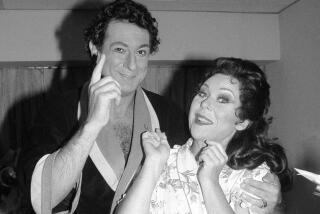Early ‘Senso’ a Victim of Wanton Disregard
- Share via
American audiences got their first look at Luchino Visconti’s “Senso” in the mid-1950s, and it wasn’t a pleasant sight. Hollywood took Visconti’s lush melodrama, handed it over to Tennessee Williams and Paul Bowles and told them to make the English-speaking version sing.
Squawk was more like it. Williams and Bowles added some bad dialogue and crudely edited “Senso” (which won the top prize at the Venice International Film Festival in 1954) from an atmospheric film into the more blatant and choppy version released here as “The Wanton Countess.” All Visconti could do was fume and wait for justice.
That didn’t happen until 1968, when Visconti’s original was released stateside. Though praised then, it had meager box-office appeal and faded fairly quickly. “Senso” can be seen tonight in Santa Ana as part of the Bowers Museum of Cultural Art’s Italian Cinema series.
The story, written by Visconti and based on a book by Camillo Boito, takes place near Venice during the 1860s, when the Austrian army occupied parts of the country. Farley Granger plays an Austrian officer, and Alida Valli is an Italian countess with a hungry way about her. They meet, their eyes lock and away they go.
The affair between Franz and the countess gives “Senso” its perfumed romanticized vibe, but Visconti uses the lovers and their small world to reveal the nationalism and revolutionary zeal that was bubbling through Italy in that era.
Visconti cuts from the couple’s heated clenches to the heated battlefields amid a flood of potent music (Visconti used Anton Bruckner’s), and you get the point that these were passionate, dangerous times. The movie demands a tragic ending, and it gets one.
It’s fitting that later in his career, Visconti--known for such films as “The Damned” (1969) and “Death in Venice” (1971)--turned to directing opera, the most atmospheric of the stage forms. He had a love of grandeur, color and huge emotions, all of which figure prominently in “Senso.”
* What: Luchino Visconti’s “Senso.”
* When: 7:30 tonight.
* Where: Bowers Museum of Cultural Art, 2002 N. Main St., Santa Ana.
* Whereabouts: Exit the Santa Ana (5) Freeway at Main Street; go south to the museum (parking adjacent on 20th Street).
* Wherewithal: Included with museum admission of $2-$6.
* Where to call: (714) 567-3600.
More to Read
Only good movies
Get the Indie Focus newsletter, Mark Olsen's weekly guide to the world of cinema.
You may occasionally receive promotional content from the Los Angeles Times.








